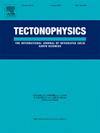Influence of horizontal stress ratio on frictional stability of fault under true triaxial stress conditions
IF 2.7
3区 地球科学
Q2 GEOCHEMISTRY & GEOPHYSICS
引用次数: 0
Abstract
To understand the fault friction stability and seismic mechanisms under in-situ stress conditions of the Earth's crust, the rectangular prismatic rock sample with a sawcut fault inclined at an angle of 29° to the axis is introduced to withstand the three stress components of true triaxial stress conditions (vertical stress σv, horizontal stress σh, and stress parallel to the strike of the fault plane σp). Velocity-stepping experiments are performed on the sawcut faults to investigate fault frictional behavior and slip stability under different σh/σp ratios and stress σp within the rate-and-state framework. Results indicate that increasing σh/σp ratios decrease the frictional velocity-dependent parameter (a-b), exhibiting a transition from velocity-strengthening to velocity-weakening behaviors. Shallow grooves develop along the fault surface and act as stress barriers at the low σh/σp ratio. With increasing σh/σp ratios, the fault surface gradually converges to uniform smoothness due to asperity abrasion, suggesting that the weakening effect of increasing σh/σp ratios on fault stability is related to stress redistribution. The enhanced fault critical stiffness (Kc) with increasing σh/σp ratios promotes fault instability nucleation. Our results reveal that true triaxial in-situ stress states in seismogenic zones exert significant control on frictional behavior and fault stability.
真三轴应力条件下水平应力比对断层摩擦稳定性的影响
为了解地壳原位应力条件下的断层摩擦稳定性和地震机制,引入了与轴线成 29°角倾斜的锯切断层矩形棱柱岩样,以承受真实三轴应力条件下的三个应力分量(垂直应力 σv、水平应力 σh 和平行于断层面走向的应力 σp)。在锯切断层上进行了速度步进实验,以研究在速率-状态框架内不同 σh/σp 比值和应力 σp 条件下的断层摩擦行为和滑移稳定性。结果表明,σh/σp 比值增大会降低摩擦速度相关参数 (a-b),表现出从速度增强到速度减弱的过渡行为。沿断层表面形成浅槽,在低σh/σp 比时充当应力屏障。随着σh/σp比值的增加,断层表面会因表面磨损而逐渐趋于均匀光滑,这表明σh/σp比值的增加对断层稳定性的削弱作用与应力再分布有关。随着σh/σp比率的增加,断层临界刚度(Kc)增强,从而促进了断层不稳定性的成核。我们的研究结果表明,震源区真实的三轴原位应力状态对摩擦行为和断层稳定性具有重要的控制作用。
本文章由计算机程序翻译,如有差异,请以英文原文为准。
求助全文
约1分钟内获得全文
求助全文
来源期刊

Tectonophysics
地学-地球化学与地球物理
CiteScore
4.90
自引率
6.90%
发文量
300
审稿时长
6 months
期刊介绍:
The prime focus of Tectonophysics will be high-impact original research and reviews in the fields of kinematics, structure, composition, and dynamics of the solid arth at all scales. Tectonophysics particularly encourages submission of papers based on the integration of a multitude of geophysical, geological, geochemical, geodynamic, and geotectonic methods
 求助内容:
求助内容: 应助结果提醒方式:
应助结果提醒方式:


